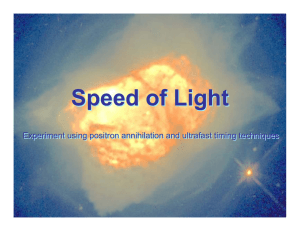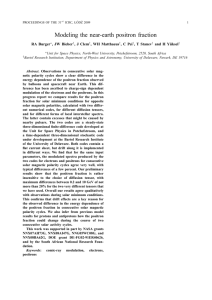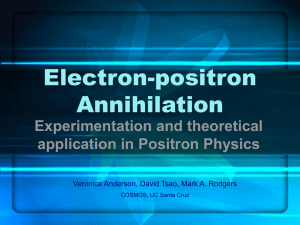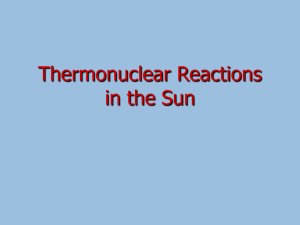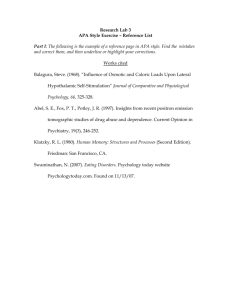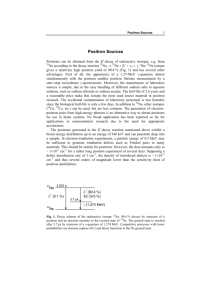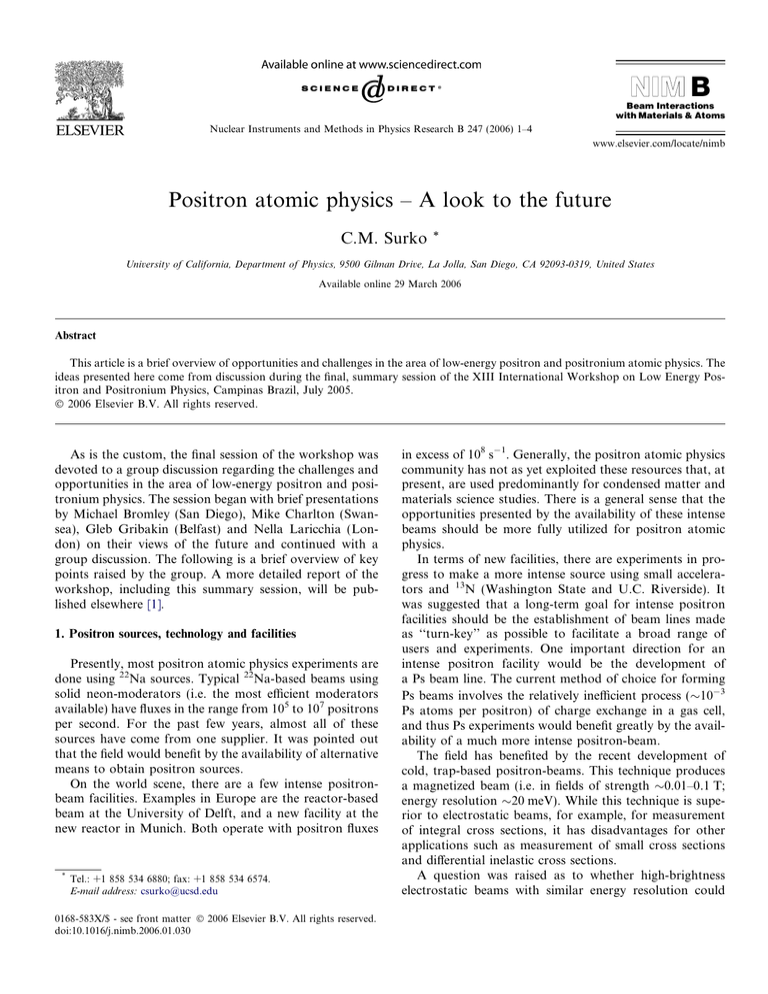
NIM B
Beam Interactions
with Materials & Atoms
Nuclear Instruments and Methods in Physics Research B 247 (2006) 1–4
www.elsevier.com/locate/nimb
Positron atomic physics – A look to the future
C.M. Surko
*
University of California, Department of Physics, 9500 Gilman Drive, La Jolla, San Diego, CA 92093-0319, United States
Available online 29 March 2006
Abstract
This article is a brief overview of opportunities and challenges in the area of low-energy positron and positronium atomic physics. The
ideas presented here come from discussion during the final, summary session of the XIII International Workshop on Low Energy Positron and Positronium Physics, Campinas Brazil, July 2005.
Ó 2006 Elsevier B.V. All rights reserved.
As is the custom, the final session of the workshop was
devoted to a group discussion regarding the challenges and
opportunities in the area of low-energy positron and positronium physics. The session began with brief presentations
by Michael Bromley (San Diego), Mike Charlton (Swansea), Gleb Gribakin (Belfast) and Nella Laricchia (London) on their views of the future and continued with a
group discussion. The following is a brief overview of key
points raised by the group. A more detailed report of the
workshop, including this summary session, will be published elsewhere [1].
1. Positron sources, technology and facilities
Presently, most positron atomic physics experiments are
done using 22Na sources. Typical 22Na-based beams using
solid neon-moderators (i.e. the most efficient moderators
available) have fluxes in the range from 105 to 107 positrons
per second. For the past few years, almost all of these
sources have come from one supplier. It was pointed out
that the field would benefit by the availability of alternative
means to obtain positron sources.
On the world scene, there are a few intense positronbeam facilities. Examples in Europe are the reactor-based
beam at the University of Delft, and a new facility at the
new reactor in Munich. Both operate with positron fluxes
*
Tel.: +1 858 534 6880; fax: +1 858 534 6574.
E-mail address: csurko@ucsd.edu
0168-583X/$ - see front matter Ó 2006 Elsevier B.V. All rights reserved.
doi:10.1016/j.nimb.2006.01.030
in excess of 108 s1. Generally, the positron atomic physics
community has not as yet exploited these resources that, at
present, are used predominantly for condensed matter and
materials science studies. There is a general sense that the
opportunities presented by the availability of these intense
beams should be more fully utilized for positron atomic
physics.
In terms of new facilities, there are experiments in progress to make a more intense source using small accelerators and 13N (Washington State and U.C. Riverside). It
was suggested that a long-term goal for intense positron
facilities should be the establishment of beam lines made
as ‘‘turn-key’’ as possible to facilitate a broad range of
users and experiments. One important direction for an
intense positron facility would be the development of
a Ps beam line. The current method of choice for forming
Ps beams involves the relatively inefficient process (103
Ps atoms per positron) of charge exchange in a gas cell,
and thus Ps experiments would benefit greatly by the availability of a much more intense positron-beam.
The field has benefited by the recent development of
cold, trap-based positron-beams. This technique produces
a magnetized beam (i.e. in fields of strength 0.01–0.1 T;
energy resolution 20 meV). While this technique is superior to electrostatic beams, for example, for measurement
of integral cross sections, it has disadvantages for other
applications such as measurement of small cross sections
and differential inelastic cross sections.
A question was raised as to whether high-brightness
electrostatic beams with similar energy resolution could
2
C.M. Surko / Nucl. Instr. and Meth. in Phys. Res. B 247 (2006) 1–4
be developed. This does not appear to be out of the question using brightness-enhancing techniques currently under
development. In this same vein, if such an electrostatic
beam were available; it could, for example, be used with
the COLTRIMS technique to measure multiple final-state
projectiles resulting from a collision, and the ‘‘magnetic
angle changer’’ technique to study scattering over a wide
range of angles. Both of these latter techniques have made
tremendous contributions in the conventional areas of electron and ion scattering.
The group was enthusiastic about the new positron
atomic physics and materials science facility currently
being established at the Australian National University
in Canberra. As currently planned, the facility will have
a magnetically guided, trap-based beam, using a
22
Na/neon-moderator positron source.
The development of colder positron-beams (e.g. resolution 1 meV, FWHM), now in progress, would be a welcome development. Applications include more precise
studies of threshold phenomena and searches for narrow
resonances. In a similar vein, techniques to produce larger,
denser and colder positron plasmas would facilitate
increased production of low-energy antihydrogen and study
of the Ps2 molecule, BEC Ps and electron–positron plasmas.
2. Positron and positronium interactions – experiment
There are many areas where further and/or more refined
experiments are needed. Examples include positron-impact
ionization (including positronium formation), which would
benefit from study of the differential cross sections, for
example, to provide more stringent tests of theory. Careful
studies of annihilation and Ps formation up to and through
the threshold would be of interest to test the precise theoretical predictions that are now available. There is a discrepancy between prediction and experiment for the peak
in the positronium formation cross section in helium that
should be further investigated. The formation of Ps on
inner-shell orbitals has been the subject of considerable
speculation and requires definitive experimental study.
In the area of electronic excitation of molecules, sharp,
near-threshold increases in the cross sections for excitation
of the lowest-lying electronic states have been observed in
N2 and CO. The origin of these features is not understood
and currently the subject of considerable theoretical interest. There are also significant discrepancies between theory
and experiment in the positron analogue of the ‘‘e ! 2e’’
problem (i.e. correlation of final-state particles in direct
ionization). These discrepancies and more refined electron–positron correlation experiments should be pursued.
Comparative studies of positron- and electron-impact cross
sections, such as those planned for the new Canberra positron facility, are likely to be very insightful.
While simple targets are of great interest, study of more
complex systems would also be of value. Examples include
the noble gas atoms, and related molecular sequences such
as CH4, CF4, CCl4, CBr4. This would, for example, aid in
the development and testing of theories, including their
ability to describe strong electron–positron correlation
effects in scattering, annihilation and positron binding.
Such studies would also provide information about positron interaction with the vibrational degrees of freedom
and their effect in enhancing annihilation rates.
The area of Ps scattering with atoms and molecules has
been much less well explored. There are many open issues
in this area, such as the details of inelastic collisions, Psbreakup, target ionization and doubly inelastic processes.
3. New experiments
Thus far, most atomic and molecular targets have been
studied at 300 K, particularly in experiments with trapbased beams. More work with heated and cooled targets
would be very useful. One example discussed was study
of atomic clusters such as C60, where cage-like resonant
states have been predicted. Another example is trap-based
beam studies of alkali atoms.
It has been shown theoretically that positrons can bind
to certain classes of atoms, and positron binding energies
have been predicted for approximately ten atoms. This is
a very important area for future experiments, although
detection schemes to date appear to range from challenging
to very challenging.
Should the new generation of planned cold positronbeams become a reality (i.e. with approximately meV
energy resolution), it would open up a wide variety of possibilities, such as precise study of threshold phenomena and
the investigation of narrow resonances. An example is the
vibrational Feshbach resonances observed in positron
annihilation on hydrocarbons, where the currently available resolution (20 meV) is inadequate to resolve individual vibrational modes.
In the more challenging category, positron- and Psimpact studies involving excited-state targets such as
He(3S) and other metastable noble gas atoms would be of
considerable interest and could possibly be done with the
target species in an atom trap.
4. Positron and positronium interactions – theory
A number of recent developments and outstanding
issues in positron atomic physics theory were discussed.
The view was expressed that, for noble gas atoms, manybody theory now provides a good understanding of the role
of correlation effects, both in low-energy elastic scattering
and annihilation. Interestingly, it was found that this
requires a nonperturbative description of virtual Ps formation (i.e. through calculation of the electron–positron, ladder-diagram series). The next challenge will be to extend
the theory to higher positron energies, where the Ps formation channel is open. Another view is that a full, quantitative theory of positron annihilation has yet to be achieved.
One issue mentioned is the role of p-waves in annihilation
resonances, where open questions remain.
C.M. Surko / Nucl. Instr. and Meth. in Phys. Res. B 247 (2006) 1–4
While various methods, such as coupled-channel
approximations, the configuration interaction formalism,
and many-body theory, have been used to make accurate
(or relatively accurate) predictions about positron interactions with a variety of atoms, much less is known theoretically about positron interactions with molecules. It is
likely, for example, that for many molecular systems, inclusion of the Ps channel (either open or closed) will be very
important in describing such processes as electronic excitation and positron binding. A view was expressed that work
by additional theoretical groups would be particularly welcome on polyatomic molecules, including the problem of
vibrational excitation.
One key area for future work is positron binding to molecules. While there is strong experimental evidence that
such an effect exists in large hydrocarbon molecules, at
present, detailed theoretical models are absent. Small molecules could provide a theoretical test bed to understand
the physical mechanisms that lead to positron binding
using a variety of theoretical techniques. To date, the only
molecules that have been shown to bind positrons are
strongly polar species that bind due to the long-range
dipole force, even in the static approximation (although
this substantially underestimates the binding energy).
The Schwinger variational approach was also a topic of
discussion. It has been used successfully to describe positron scattering from small molecules, however annihilation
appears to be a more difficult problem. It was suggested
that it might be useful to test the ability of this approach
to describe correlation effects in atomic systems, where theory and experiment are in reasonably good accord. The
group viewed as a positive development a new effort, just
beginning, to calculate positron interactions with small
molecules using the R-matrix formalism.
The problem of positron binding to large molecules
appears to be considerably more challenging. A method
sensitive to electron–positron correlations appears to be
required to describe positron resonances and binding, and
the detailed vibrational dynamics of the molecule must be
included as well. At present, this problem may be more
amenable to study using model approaches, such as use of
zero-range potentials. In general, comparison of electronmolecule and positron-molecule attachment will likely be
of considerable interest. In this regard, the standard picture
of electron capture by molecules is based on the intersection of potential surfaces corresponding to the electronic
terms describing the neutral molecule and negative ion. In
the case of positron capture (which underpins huge enhancements in annihilation rates observed for large molecules),
it is presently unclear whether a similar picture will be useful
or whether a different model of capture will be required.
3
additional benchmarks so that theory and experiment can
be compared with precision. This includes elastic scattering; rotational, vibrational and electronic excitation; single
and double direct ionization; Ps formation; and direct
annihilation. While considerable data exists for some of
these processes, such as elastic scattering and direct ionization, very little is available for others such as rotational
excitation and double ionization. The field suffers in this
regard from the small number of cases where there is more
than one experimental data set for a particular quantity to
test theory. Similarly, there is frequently only one calculation to compare with a set of measurements. To have multiple theoretical and experimental groups focus on specific
benchmark problems would be very beneficial. Examples
include precision studies of simple systems such as He
and H2. Other important targets include Hþ
2 (including
the dissociation channel) and H2O.
A number of interesting and important issues were mentioned regarding the many-positron, many-electron system
(i.e. electron–positron many-body systems). They include
the formation and study of the Ps2 molecule (experiment
in progress) and the related effort to create BEC positronium in cavities below a material surface. These experiments involve cold collisions, where for example, the
scattering length is a critical parameter. The physics here
has important synergies with current research on ultra-cold
gases.
Another very important problem is the formation of
low-energy antihydrogen. The most successful formation
process developed to date involves the merging of cold positron and antiproton plasmas in a strong magnetic field.
This produces a broad range of excited states, including
strongly magnetized, high-Rydberg atoms (i.e. so-called
guiding-center atoms). These guiding-center atoms have
interesting and unusual properties that are likely to be
the focus of much theoretical and experimental interest
for the foreseeable future. One important issue is the development of detailed and realistic simulations of situations
relevant to experiment to predict the range of excited states
produced and how these atoms are further transformed in
subsequent collisions. A related problem is the formation
of cold Ps atoms via merged positron and electron plasmas.
Another related problem discussed at the workshop is
the physics of antihydrogen–matter interactions (e.g. such
as collisions of antihydrogen with hydrogen or helium
atoms or H2). At low temperatures, description of these collisions is believed to require going beyond the Born–Oppenheimer approximation to use of a non-adiabatic formalism.
Somewhat surprisingly, strong antiproton–nucleus interactions proved to be very important in particular cases. This
area of antihydrogen collisions with matter also has important synergies with current work on ultra-cold gases.
5. Intersection of theory and experiment
6. Concluding remarks
Traditionally, hydrogen and helium are systems where
the predictions of accurate theories could be compared in
detail with experimental results. There is a great need for
This summary highlights the wealth of interesting scientific questions, which can and should be investigated, ones
4
C.M. Surko / Nucl. Instr. and Meth. in Phys. Res. B 247 (2006) 1–4
that will quite likely lead to interesting scientific results. In
the broader view, there is a continuing belief that the field
would benefit greatly by actively seeking more connections
to other areas of science. With this in mind, selectivity was
recommended in studying positron processes and phenomena with an eye toward the broader impacts of the
research. Given the range of applications of positron physics (e.g. from astrophysics to PET scans), it would be both
appropriate and beneficial for positron atomic physics to
lose the ‘‘exotic particle’’ tag. One example in this regard
is exploiting the synergy between electron-driven and positron-driven processes. More work relevant to materials
and bioscience would also aid in achieving this objective.
The availability of additional intense-beam and otherwise dedicated positron facilities presents additional opportunities. Not only can one achieve much higher data rates
and develop a range of instrumentation hard to justify in
a single laboratory, but these user facilities can be expected
to enable a broader range of scientists to exploit positron
processes to address a wide range of scientific issues.
Finally, it should be remarked that the international
nature of the theoretical and experimental positron community has led to much progress and can be expected to
do so in the future. The workshop highlighted the extensive collaborative efforts that exist across the world on
both experimental and theoretical problems of interest.
This valued tradition can be expected to serve the field
well.
Reference
[1] G. Laricchia, M.W.J. Bromley, M.A.P. Lima, Physica Scripta:
Comments on Atomic, Molecular and Optical Physics (to be submitted
for publication).



